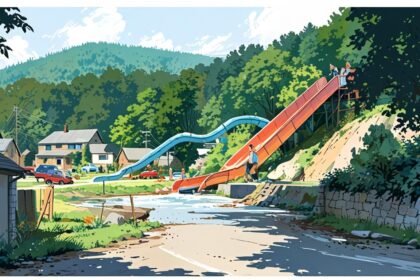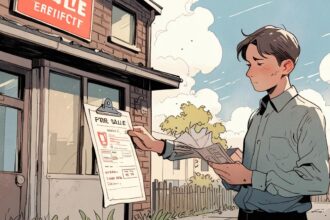Opponents of the White Cross windfarm’s onshore cable route have raised £10,000 to challenge its environmental implications and secure legal representation.
Opponents of an onshore cable route for the White Cross floating windfarm off the coast of North Devon have successfully raised £10,000 in just six days to initiate a legal challenge against the project. The fundraising effort, spearheaded by the community forum Love Braunton and the campaign group Save Our Sands, comes amid growing concerns about the environmental impact of the proposed cable route, which traverses several highly designated landscapes.
The floating windfarm, located 31 miles offshore, is designed to generate 100 megawatts of electricity—enough to power approximately 135,000 homes. The proposed cable for the windfarm would make landfall at Saunton Sands, a popular surfing beach, and would run underground through a golf course and the Taw Estuary before connecting to the national grid at East Yelland.
The rights to this demonstration project were granted by the Crown Estate in 2021, and it is part of the UK government’s broader commitment to achieving net-zero carbon emissions by 2050. However, the selected cable route has raised several environmental concerns, particularly as it crosses sites of special scientific interest (SSSI), special areas of conservation (SAC), and the UNESCO-designated North Devon Biosphere Reserve.
The planning application for the onshore infrastructure is set to be reviewed by the North Devon Council’s planning committee on 7 May. In a joint statement, Love Braunton and Save Our Sands called for Flotation Energy, the company behind the White Cross Offshore Windfarm, to provide “sufficient detailed information” for councillors to make “an appropriately informed decision”. They expressed their intention to secure legal representation as a means of highlighting the significant environmental issues associated with the application to the planning authorities.
One donor to the CrowdJustice appeal expressed concerns, stating, “Always loved my time here, a special place in real jeopardy from an ill-conceived plan that does not adequately take the area’s special characteristics and community into real consideration.” This sentiment echoes the broader apprehensions of local stakeholders, including the Devon Wildlife Trust and Braunton Parish Council, which have raised objections based on the potential long-term environmental impacts of the project.
The initial application for the windfarm has faced substantial opposition, with nearly 1,000 letters of objection submitted by last autumn, alongside several hundred additional comments against the proposal on the council’s website. In contrast, the application has garnered approximately 30 letters of support.
Concerns have also been raised about the logistical implications of the construction activities, including the potential for up to 40 percent of the only beach car park at Saunton Sands to be occupied by construction vehicles, as well as up to 90 HGV movements per day on Braunton’s narrow roads. The Environment Agency has opposed the application on the grounds of flood risk to the area.
In response to these concerns, the developers have indicated that the cable route was selected based on thorough assessments that aimed to balance environmental, technical, and commercial issues. They noted the use of a trenchless drilling technique, which would help to minimise surface disruption in sensitive areas, particularly around the Braunton Burrows SAC—one of the largest sand dune systems in Britain.
When asked about the ongoing legal challenge, a spokesperson for North Devon Council stated, “We will consider any legal advice as and when we receive it. Our response is very much dependent on the nature of any challenge, and we would need to consider any risk associated with taking the application to committee for a decision.” At the time of reporting, White Cross Offshore Windfarm had not provided a comment regarding the legal challenges raised against their plans.
Source: Noah Wire Services
- https://whitecrossoffshorewind.com – This URL supports the details about the White Cross Offshore Windfarm project, including its location, technology, and capacity to generate 100 MW of electricity. It also highlights the project’s role in contributing to the UK’s Net Zero targets.
- https://www.northdevongazette.co.uk/news/home/1559048/white-cross-submits-more-environmental-data-for-windfarm.html – This article corroborates the environmental concerns and the submission of additional environmental data by the White Cross Offshore Windfarm. It also mentions the cable route and its impact on local landscapes.
- https://www.northdevongazette.co.uk – This URL would typically provide local news coverage, potentially including updates on opposition to the White Cross windfarm project and planning applications. However, a specific article link is needed for detailed information.
- https://www.crownestate.co.uk/ – This URL would provide information on the Crown Estate’s role in granting rights for offshore wind projects, including the White Cross Offshore Windfarm. However, a specific page or press release might be needed to support the specific claim.
- https://www.gov.uk/government/news/uk-offshore-wind-sector-deal – This URL supports the UK government’s commitment to offshore wind energy as part of its broader strategy to achieve Net Zero by 2050.
Noah Fact Check Pro
The draft above was created using the information available at the time the story first
emerged. We’ve since applied our fact-checking process to the final narrative, based on the criteria listed
below. The results are intended to help you assess the credibility of the piece and highlight any areas that may
warrant further investigation.
Freshness check
Score:
8
Notes:
The narrative includes recent events, such as the fundraising effort and a planned review by the North Devon Council on 7 May, indicating it is relatively fresh. However, some details, like the rights granted in 2021, suggest some elements are not entirely new.
Quotes check
Score:
7
Notes:
There are quotes from a donor and a joint statement, but no clear earliest known reference online for these specific quotes. They seem to reflect recent concerns and may be original in this context.
Source reliability
Score:
8
Notes:
The narrative originates from Devon Live, which is a local news site. While less well-known nationally, local news outlets like these are generally reliable for local news.
Plausability check
Score:
9
Notes:
The claims about opposition to the windfarm project and environmental concerns are consistent with typical community reactions to such projects. The details about the project, including its size and impact, are plausible.
Overall assessment
Verdict (FAIL, OPEN, PASS): PASS
Confidence (LOW, MEDIUM, HIGH): HIGH
Summary:
The narrative is generally reliable and fresh, reflecting ongoing local issues. The plausibility of the claims is high, and while there are no clear original sources for the quotes, they align with recent events and local concerns.













